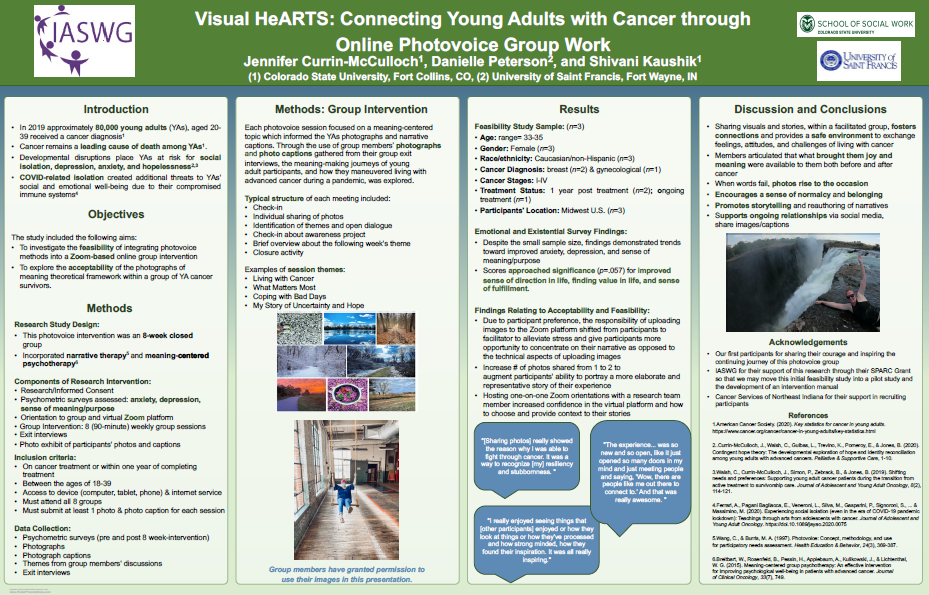Jennifer Currin-McCulloch, Colorado State University, Fort Collins, CO (USA)
Danielle Peterson, University of Saint Francis, Fort Wayne, IN (USA)
Shivani Kaushik, Colorado State University, Fort Collins, CO (USA)
This presentation will describe the planning through evaluative stages of an online photovoice group that included young adults with cancer. A discussion of the group dynamics that resulted from the members’ stage of life, various disease states, and goals for entering the group is offered. Attendees will gain an understanding of how to integrate photovoice methods in a virtual platform for the purpose of connecting young adults with cancer and other socially vulnerable populations.

View PDF of Poster / To learn more, download the Presentation Handout.
Presentation Description:
Last year, in the United States, approximately 80,000 young adults (YAs), aged 20-39 received a cancer diagnosis (ACS, 2020). Although cancer remains a leading cause of death among YAs, they represent only 5% of the nation’s annual cancer diagnoses. Thus, placing these individuals within a minority, with unique ill-related developmental disruptions that create social isolation, depression, anxiety, and hopelessness (Currin-McCulloch et al., 2020; Walsh et al., 2019). During the coronavirus pandemic (COVID-19), many YAs suffered additional threats to their social and emotional well-being, due to their compromised immune systems and need for extreme isolation precautions to reduce the risk for contracting COVID (Ferrari et al., 2020). To support these socially and emotionally vulnerable YAs, the authors developed a virtual 8-week social group work intervention that engaged photovoice methods and meaning-centered psychotherapy. The aim of this novel group work intervention was to investigate the feasibility of integrating photovoice methods into a Zoom-based online platform, and to explore the acceptability of the theoretical frameworks within a group of YAs. This photovoice intervention was an 8-week closed group that drew from the theoretical frameworks of narrative therapy and meaning-centered psychotherapy. A form of narrative therapy (Wang & Burris), photovoice facilitates meaning-making through the construction and reconstruction of personal experiences, gives a structured, yet flexible framework for mutual aid, and culminates with participants raising awareness of an issue that is of personal import. Meaning-centered psychotherapy, an intervention commonly utilized among individuals with advanced cancers (Breitbart et al., 2015), offers a clinical framework for understanding of the meaning one’s illness plays in their lives, as well as fostering a sense of purpose. Each photovoice session focused on a meaning-centered topic which informed the YAs photographs and narrative captions. Session topics included themes such as living with cancer; coping with bad days; understanding my roots; and living life to the fullest. Through the use of group members’ photographs and quotes gathered from their group exit interviews, this presentation will explore the meaning-making journeys of young adult participants and how they maneuvered living with advanced cancer during a pandemic. Attendees will gain an understanding of how to integrate photovoice methods in a virtual platform for the purpose of connecting young adults with cancer. This poster presentation will explain the progression of the planning through evaluative stages of a photovoice group that included young adults with cancer. A discussion of the group dynamics that resulted from the members’ stage of life, various disease states, and goals for entering the group is offered. Following this presentation, attendees should be better able to:1) Gather concrete strategies for implementing an online photovoice group intervention with populations such as young adults or those with life-limiting medical conditions2) Describe how sharing visuals and stories, within a facilitated group, fosters connections and provides a safe environment to exchange feelings, attitudes, and challenges of living with cancer. 3) Identify several key themes of meaning-centered psychotherapy that one could engage in social group work to reduce social isolation and feelings of hopelessness.
References:
- American Cancer Society. (2020). Key statistics for cancer in young adults. https://www.cancer.org/cancer/cancer-in-young-adults/key-statistics.html
- Breitbart, W., Rosenfeld, B., Pessin, H., Applebaum, A., Kulikowski, J., & Lichtenthal, W. G. (2015). Meaning-centered group psychotherapy: An effective intervention for improving psychological well-being in patients with advanced cancer. Journal of Clinical Oncology, 33(7), 749.
- Currin-McCulloch, J., Walsh, C., Gulbas, L., Trevino, K., Pomeroy, E., & Jones, B. (2020). Contingent hope theory: The developmental exploration of hope and identity reconciliation among young adults with advanced cancers. Palliative & Supportive Care, 1-10.
- Ferrari, A., Pagani Bagliacca, E., Veneroni, L., Silva, M., Gasparini, P., Signoroni, S., ... & Massimino, M. (2020). Experiencing social isolation (even in the era of COVID-19 pandemic lockdown): Teachings through arts from adolescents with cancer. Journal of Adolescent and Young Adult Oncology. https://doi.10.1089/jayao.2020.0075
- Walsh, C., Currin-McCulloch, J., Simon, P., Zebrack, B., & Jones, B. (2019). Shifting needs and preferences: Supporting young adult cancer patients during the transition from active treatment to survivorship care. Journal of Adolescent and Young Adult Oncology, 8(2), 114-121.
- Wang, C., & Burris, M. A. (1997). Photovoice: Concept, methodology, and use for participatory needs assessment. Health Education & Behavior, 24(3), 369-387.

